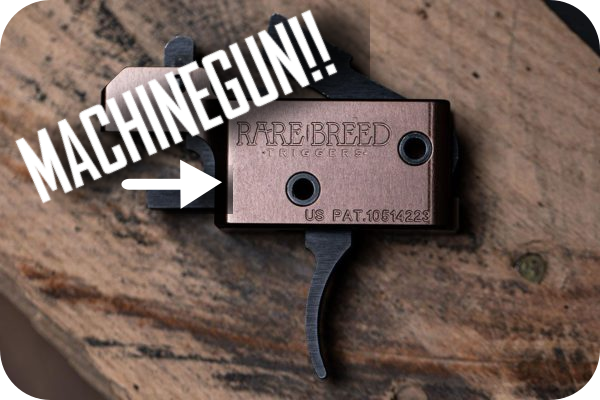The ATF recently sent out a letter to all FFL’s(text of it is all below) saying about forced reset triggers (FRTs) “some of them are firearms and machineguns as defined by the National Firearms Act (NFA).” Nevermind that according to the laws set by Congress, they are absolutely not. In fact, in the letter the ATF contradicts themselves. They state the definition of a machinegun, as defined by US law is Any weapon which shoots, is designed to shoot, or can be readily restored to shoot, automatically more than one shot, without manual reloading, by a single function of the trigger. They then state their reasoning for calling FRTs machineguns is they do not require shooters to pull and then subsequently release the trigger to fire a second shot(this is false). Notice they change the wording ‘function of the trigger’ to ‘pull and release.’ These are not the same thing.
The ATF has long said that a function of the trigger is from the rest position to the rear position. Then from the rearward position to the forward position is another function. This is their reasoning for allowing binary triggers, which shoot one shot with a pull of the trigger and one shot with a release. Keep in mind those are still completely legal, so they’re admitting that definition hasn’t changed.
So how then can a trigger that only shoots one shot with TWO functions of the trigger, which is how the FRT works, be considered a machinegun? A pull of the trigger, which is what your finger does, and a function of the trigger, which is what the trigger does, are two completely different things.
Lawrence DeMonico, the owner of Rare Breed Firearms and Rare Breed Triggers does a fantastic job of explaining everything that is going on. He posted it on their facebook, and Reno May posted it on his Youtube, which is embedded below.
March 22, 2022
OPEN LETTER TO ALL FEDERAL FIREARMS LICENSEES
The Bureau of Alcohol, Tobacco, Firearms and Explosives (ATF) recently examined devices
commonly known as “forced reset triggers” (FRTs) and has determined that some of them are
“firearms” and “machineguns” as defined in the National Firearms Act (NFA), and
“machineguns” as defined in the Gun Control Act (GCA).
These particular FRTs are being marketed as replacement triggers for AR-type firearms. Unlike
traditional triggers and binary triggers (sometimes referred to generally as “FRTs”), the subject
FRTs do not require shooters to pull and then subsequently release the trigger to fire a second
shot. Instead, these FRTs utilize the firing cycle to eliminate the need for the shooter to release
the trigger before a second shot is fired. By contrast, some after-market triggers have similar
components but also incorporate a disconnector or similar feature to ensure that the trigger must
be released before a second shot may be fired and may not be machineguns.
Both the NFA and GCA regulate machineguns. “Machinegun” is defined under 26 U.S.C.
§ 5845(b) and 18 U.S.C. § 921(a)(23) as—
Any weapon which shoots, is designed to shoot, or can be readily restored to shoot,
automatically more than one shot, without manual reloading, by a single function of the
trigger. The term shall also include the frame or receiver of any such weapon, any part
designed and intended solely and exclusively, or combination of parts designed and
intended, for use in converting a weapon into a machinegun, and any combination of
parts from which a machinegun can be assembled if such parts are in the possession or
under the control of a person. (Emphasis added.)
ATF’s examination found that some FRT devices allow a firearm to automatically expel more
than one shot with a single, continuous pull of the trigger. For this reason, ATF has concluded
that FRTs that function in this way are a combination of parts designed and intended for use in
converting a weapon into a machinegun, and hence, ATF has classified these devices as a
“machinegun” as defined by the NFA and GCA.
Accordingly, ATF’s position is that any FRT that allows a firearm to automatically expel more
than one shot with a single, continuous pull of the trigger is a “machinegun”, and is accordingly
subject to the GCA prohibitions regarding the possession, transfer, and transport of machineguns
OPEN LETTER TO ALL FEDERAL FIREARMS LICENSEES (cont.)
under 18 U.S.C. §§ 922(o) and 922(a)(4). They are also subject to registration, transfer, taxation,
and possession restrictions under the NFA. See 26 U.S.C. §§ 5841, 5861; 27 CFR 479.101.
Under 26 U.S.C. § 5871, any person who violates or fails to comply with the provisions of the
NFA may be fined up to $10,000 per violation and is subject to imprisonment for a term of up to
ten years. Further, pursuant to 26 U.S.C. § 5872, any machinegun possessed or transferred in
violation of the NFA is subject to seizure and forfeiture. Under 18 U.S.C. § 924(a)(2), any
person who violates § 922(o) may be sent to prison for up to 10 years and fined up to $250,000
per person or $500,000 per organization.
Based on ATF’s determination that the FRTs that function as described above are
“machineguns” under the NFA and GCA, ATF intends to take appropriate remedial action with
respect to sellers and possessors of these devices. Current possessors of these devices are
encouraged to contact ATF for further guidance on how they may divest possession. If you are
uncertain whether the device you possess is a machinegun as defined by the GCA and NFA,
please contact your local ATF Field Office. You may consult the local ATF Office’s webpage
for office contact information.
Assistant Director
Enforcement Programs and Services
George Lauder
Assistant Director
Field Operations


Recent Comments